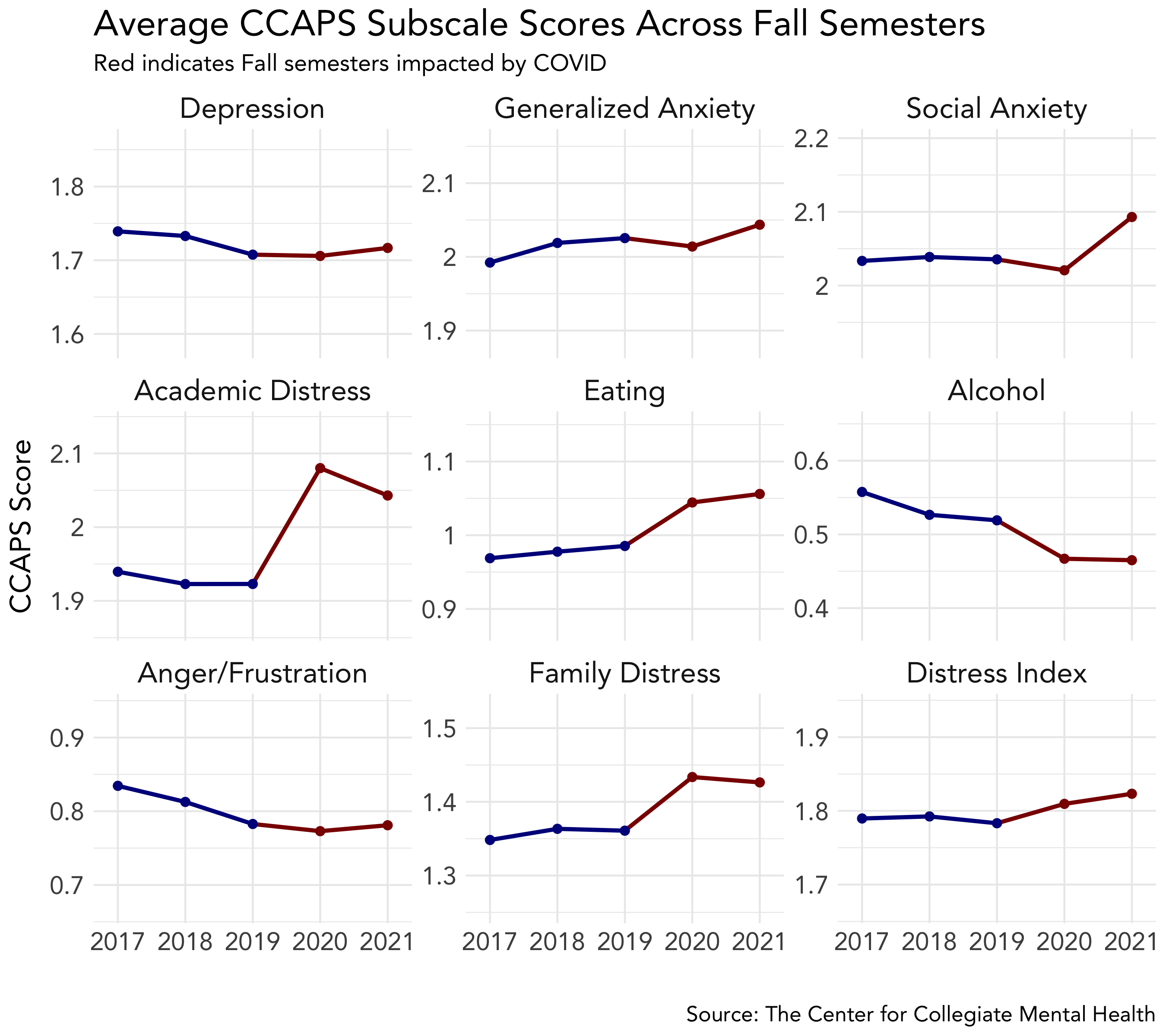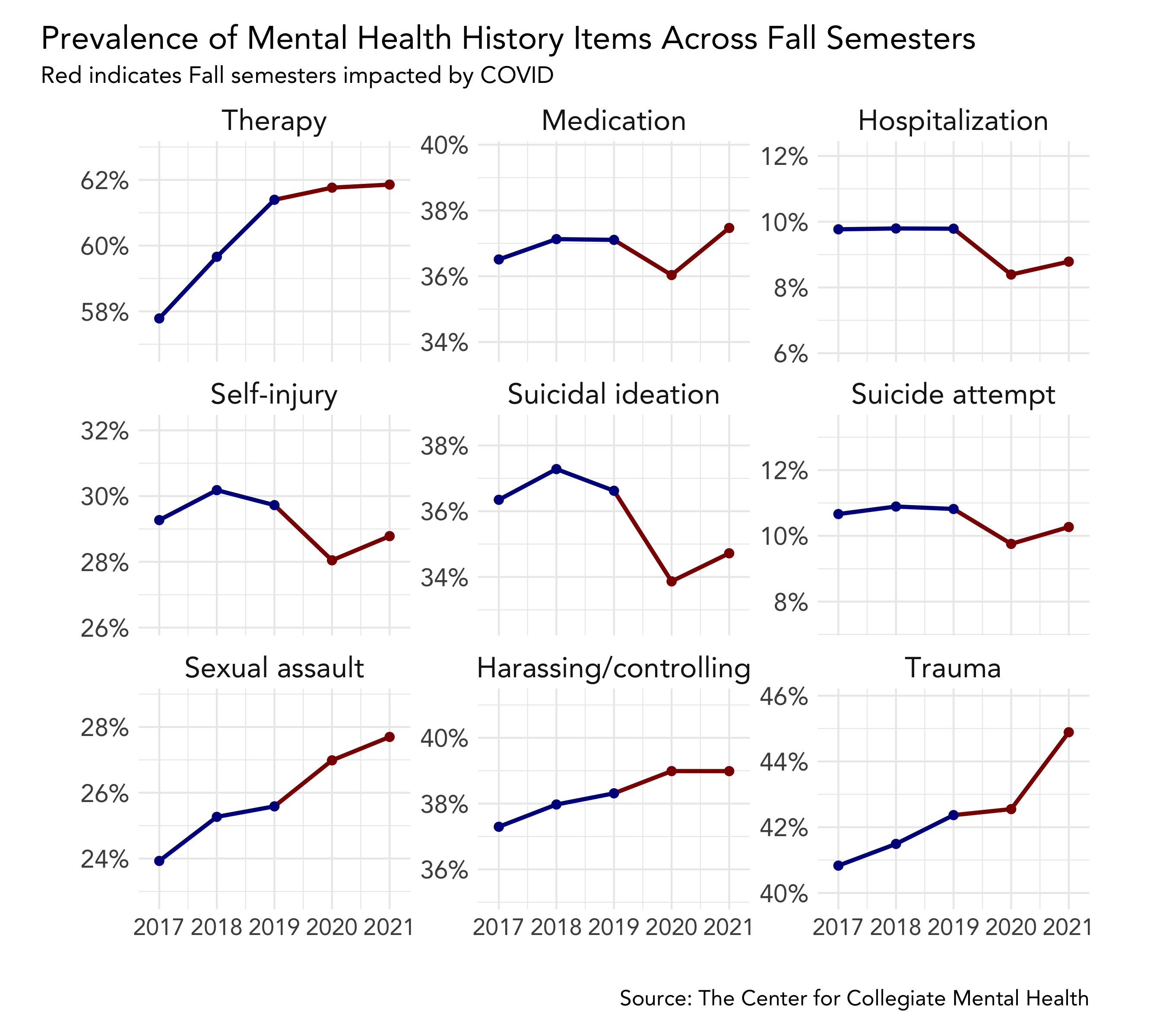Fall 2021: COVID-19 Impact on College Student Mental Health
In February 2021, CCMH released a 5-part blog series that examined the initial impacts of COVID-19 on college students seeking treatment for mental health concerns. In Blog 2 of 5, CCMH compared student distress levels before and after the onset of COVID-19 using data from Fall 2019 and Fall 2020. This blog expands on those analyses and explores the following questions using updated data from Fall 2021.
- How did students’ self-reported psychological distress change between Fall 2019 (Pre-COVID) and Fall 2021?
- How did students’ self-report of lifetime mental health events (e.g. treatment, threat-to-self characteristics, and traumatic events) change between Fall 2019 (Pre-COVID) and Fall 2021?
Did students’ self-reported psychological distress change between Fall 2019 (Pre-COVID) and Fall 2021?
Students seen for services at CCMH participating counseling centers complete the Counseling Center Assessment of Psychological Symptoms (CCAPS) to measure psychological distress at their first appointment. Using data from 243,694 students seeking services from 85 college counseling centers, CCMH examined changes in average psychological distress across multiple fall semesters. Five years of data from Fall 2017 (Pre-COVID) through Fall 2021 were used to evaluate trends both pre- and post-onset of COVID-19. This included 55,027 clients seen in Fall 2021. The figures below plot the average CCAPS subscale scores for each semester. The semesters in blue represent average distress scores of students prior to the onset of COVID-19, and the semesters impacted by COVID-19 are in red.


Overall, students reported small to moderate increases in distress across most CCAPS Subscales (Depression, Generalized Anxiety, Social Anxiety, Academic Distress, Eating Concerns, Family Distress, and Overall Distress) in the Fall 2021 compared to the Pre-COVID Fall 2019. The areas of exception were Anger/Frustration, which displayed minimal to no change, and Alcohol Use, which demonstrated a moderate decline.
Social Anxiety and Academic Distress demonstrated the most notable increases between Fall 2019 and 2021, with both clearly increasing beyond their Pre-COVID trajectories. Specifically, Social Anxiety significantly increased from Fall 2020 to 2021. Upon further examination of the Social Anxiety items, the increase was not driven by isolated changes in any particular symptoms, as all symptoms were elevated compared to Fall 2020. Additionally, while Academic Distress slightly decreased from Fall 2020 to 2021, it continued to remain considerably higher than the Pre-COVID Fall 2019 level.
Family Distress and Eating Concerns demonstrated moderate increases between Fall 2019 and Fall 2021 above their Pre-COVID trends. Depression, Generalized Anxiety, and Overall Distress displayed slight increases between Fall 2020 and Fall 2021, representing minor departures from prior trends.
Did students’ self-report of mental health history events change between Fall 2019 (Pre-COVID) and Fall 2021?
Students receiving care at participating centers also complete mental health history items from the Standardized Data Set (SDS) prior to treatment. Using data from 262,517 students seeking services from 98 college counseling centers, CCMH examined changes in prevalence of various lifetime mental health events across five Fall semesters (2017 to 2021). This included 56,262 clients seen in Fall 2021. The charts below illustrate these data by plotting the changes in mental health events, with Pre-COVID Fall semesters in blue, and those impacted by COVID-19 in red.


In terms of self-reported prior treatment (therapy, medication, hospitalization), rates of students with prior therapy plateaued in Fall 2020 and 2021 after substantially increasing each year prior to the onset of COVID. Rates of prior medication use decreased in Fall 2020 but rebounded to slightly above pre-COVID levels in Fall 2021. Finally, rates of prior hospitalization increased slightly in Fall 2021 after declining in Fall 2020, however, the rates continued to fall below the pre-COVID levels.
When examining threat-to-self characteristics, lifetime history of self-injury, suicidal ideation, and suicide attempts decreased in Fall 2020 compared to Fall 2019. However, they subsequently increased in Fall 2021 but remained below their pre-COVID levels.
In terms of traumatic events, rates of prior sexual assault and trauma increased after the onset of COVID, while the experience of harassing/controlling behavior initially rose from Fall 2019 to 2020 but plateaued in Fall 2021. Additionally, it is particularly notable that self-reported experiences of lifetime trauma increased at a rate that was more substantial than the pre-COVID trajectory.
Summary
In this blog, CCMH examined how self-reported distress and lifetime history of mental health events changed among students seeking college counseling services between Fall 2017 and 2021. The following findings were the most notable:
- Compared to pre-COVID Fall semesters, there were moderate to substantial increases in Academic Distress, Social Anxiety, Family Distress, and Eating Concerns in the Fall 2021. While other areas of distress slightly changed in Fall 2021 (Depression, Generalized Anxiety, General Distress minimally increasing, Alcohol Use slightly decreasing, and Anger/Frustration flattening), these changes were very consistent with their pre-COVID tends.
- Rates of prior therapy plateaued after substantial annual increases prior to the onset of COVID. The proportion of students reporting lifetime threat-to-self characteristics (self-injury, suicidal ideation, and suicide attempt) declined in Fall 2020 compared to Fall 2019, and they rebounded in Fall 2021, but they continued to fall below the pre-COVID levels. Finally, the rate of lifetime trauma continued to increase in Fall 2020 and 2021, which was well above the pre-COVID trend.
There are ongoing critical questions about the impact of COVID-19 on collegiate mental health. While more longitudinal data will be needed to better answer these complicated and nuanced questions, the findings in this blog shed new light on this topic using recent data from students seeking counseling services nationally in the Fall 2021. Although numerous areas of distress increased at least somewhat in Fall 2021 compared to pre-COVID levels, the rise in Academic Distress, Social Anxiety, Family Distress, Eating Concerns, and lifetime experiences of trauma and sexual assaults were particularly notable. These findings highlight the importance for colleges and universities to be proactive in supporting the mental health needs of students as they cope with these elevated levels of distress and adapt to life during these challenging times. Additionally, during the Fall 2020 and 2021, students presenting for services were less likely than pre-COVID Fall semesters to report prior medication use, psychiatric hospitalization, self-injury, serious suicidal ideation and suicide attempts, potentially indicating that centers were treating more clients with new onset mental health concerns than in previous semesters. This may be due to students taking advantage of teletherapy who otherwise would not have sought services. Alternatively, it may be a result of students with a more extensive mental health histories remaining in treatment remotely with pre-college mental health providers instead of seeking services at their college counseling center.
While these updated trends confirm that COVID-19 is associated with increases in distress across many areas, they also reinforce the findings from our previous COVID blogs, that the exact impacts are nuanced, as students are not presenting with increased distress in all domains. Future data will need to be collected to determine whether areas of concern (Academic Distress, Social Anxiety, Family Distress, Eating Concerns, and lifetime experiences of trauma and sexual assaults) as well as rates of prior mental health treatment will continue to display their notable departures from pre-COVID trends or whether COVID will have a more sustained impact on these areas for students seeking mental health services at college counseling centers.

